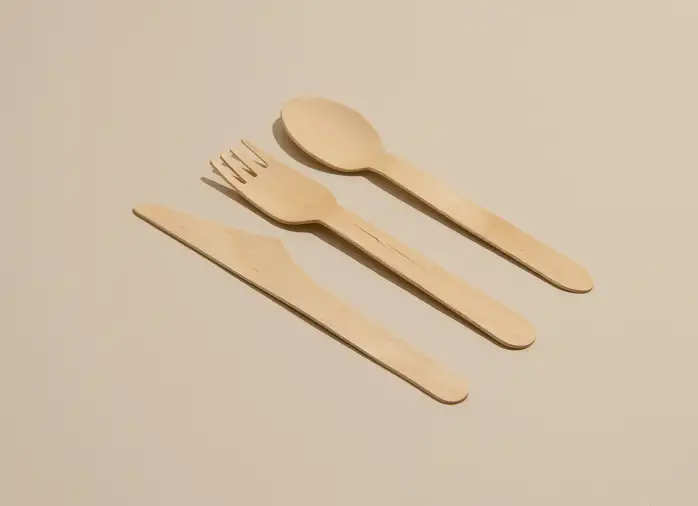A History of Wooden Cutlery
Cutlery has been around for centuries, and while the materials used to make it have changed over time, the principle behind it has not. In this article, we will take a look at the history of wooden Cutlery, starting with ancient Egypt and Greece. We'll see how knife-making progressed through the Middle Ages and Renaissance, and how steel replaced wood as the material of choice for Cutlery in the late 1800s. By the end of our journey, you will be well-equipped to make an informed purchase when choosing Cutlery for your kitchen.
The Beginnings of Wooden Cutlery
The history of wooden Cutlery dates back to prehistoric times when people used bone or stone knives and forks. The first true wooden Cutlery was crafted in China around 200 BC. Wooden Cutlery quickly became popular due to its durability and ease of use. As technology improved, so did Wooden Cutlery. In the early 1800s, metal cutlery began to replace Wooden Cutlery due to its greater durability and lighter weight. However, Wooden Cutlery has continued to be popular throughout the centuries, especially in countries where metal cutlery is not affordable or available. Today, Wooden Cutlery is still commonly used in countries such as India and China, as well as in traditional European restaurants.
The Birth of the American Cutlery Industry
The history of wooden cutlery can be traced back to the early 18th century. In 1733, Benjamin Franklin patented his own knife, which was made out of hardwood. This helped spur the development of the American Cutlery Industry.
In 1795, Lewis Latimer patented his style of wooden folding knife. This design became very popular and is still in use today. Latimer’s design allowed for knives to be easily carried in a pocket or purse, which helped increase their popularity.
The American Cutlery Industry really took off in the late 1800s and early 1900s. This was due to a number of factors, including the development of transportation and manufacturing technologies. The industry also benefited from increased consumer demand for knives and other kitchen tools.
Today, the American Cutlery Industry continues to be one of the most important sectors in the US economy. It employs a large number of people and makes a significant contribution to the country’s GDP.

The Technological Advancements of Wooden Cutlery
The history of wooden cutlery is a story of technological advancements and innovation. Wooden utensils have been used for cooking and eating for centuries, but it was not until the 20th century that wooden cutlery began to take on a new level of sophistication.
In the early days of the 20th century, wood was an expensive and rare resource. So, it was not until the 1950s that wooden utensils started to become more popular. This was due to the fact that plastic utensils became widely available in the 1940s, and porcelain dishes became more common in the 1950s and 1960s.
However, there were still some people who preferred using wooden utensils. This is because they believed that wood had a better flavor than plastic or porcelain. In addition, wooden utensils are environmentally friendly since they do not require any chemicals or treatments to keep them clean.
Today, wooden cutlery is still popular among some people. However, it has started to become more popular among professional chefs because of its unique texture and flavor.
The Decline of Wooden Cutlery
Historically, wooden cutlery was a popular choice for people because of its affordability and convenience. But over the years, the popularity of plastic cutlery has led to the decline of wooden cutlery.
The first wooden cutlery was invented in China around 1000 AD. Wood became a popular choice for cutlery because it was strong and easy to work with. Wooden Cutlery continued to be popular until the early 1900s, when plastic began to become more popular.
The main reason that plastic became more popular is because it is easier to clean. Plastic also doesn't corrode, which makes it a better option for food safety. And lastly, plastic is less expensive than wooden cutlery.
Although wooden cutlery is no longer as popular as it once was, it remains an iconic piece of history.
The Rebirth of Wooden Cutlery
Traditional wooden cutlery has been making a comeback in recent years as a more sustainable option than metal cutlery. Here's a history of wooden Cutlery from its origins to its resurgence in recent years.
Wooden Cutlery has been around for centuries, but it wasn't until the recent years that it has made a comeback. There are many reasons why wooden cutlery is gaining popularity, but the main reason is that it is eco-friendly.
One of the first places where wooden cutlery was popularized was in Japan. There, people were starting to become more conscious about their environment and how they were impacting it. They realized that wooden utensils were much more environmentally friendly than their metal counterparts, and so they started to use them more often.
In the U.S., there has also been a resurgence in wooden cutlery. Part of this is because of the popularity of wellness lifestyles, which emphasizes using natural ingredients and products. Another reason is that people are starting to realize that traditional wooden cutting boards are a sustainable resource timber. Not to mention, they're also just really beautiful things to use!
There are a lot of different types of wooden Cutlery out there, so if you're interested in trying out some, be sure to check out some of the options available on Etsy
Conclusion
Cutlery has a long and varied history, which is evident in the variety of wooden Cutlery that is available today. From traditional kitchen knives and forks to steak knives and carving boards, WoodenCutlery.com offers an extensive range of wood-handled tools that can be customized to perfectly fit your needs. With so many options available, it's easy to find the perfect Wooden Cutlery for your home or kitchen!







